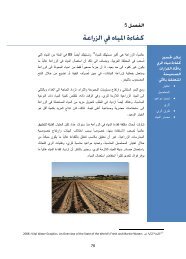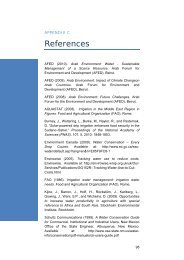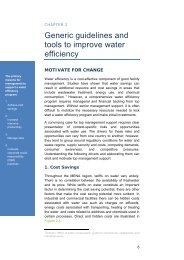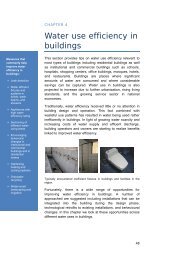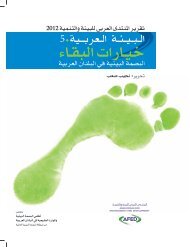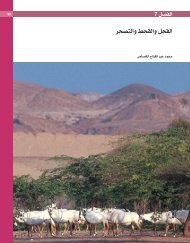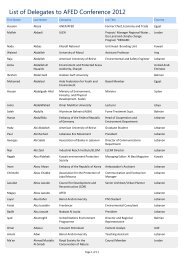Impact of Climate Change on Arab Countries - (IPCC) - Working ...
Impact of Climate Change on Arab Countries - (IPCC) - Working ...
Impact of Climate Change on Arab Countries - (IPCC) - Working ...
Create successful ePaper yourself
Turn your PDF publications into a flip-book with our unique Google optimized e-Paper software.
ARAB ENVIRONMENT: CLIMATE CHANGE 91<br />
“The predicted trend towards increasingly variable<br />
rainfall is likely to increase the risk <str<strong>on</strong>g>of</str<strong>on</strong>g> weather-related<br />
natural disasters, such as floods... It is<br />
possible that climate change may also change the<br />
frequency <str<strong>on</strong>g>of</str<strong>on</strong>g> other weather disasters, such as<br />
wind storms, but there is less agreement about<br />
the nature and magnitude <str<strong>on</strong>g>of</str<strong>on</strong>g> change. C<strong>on</strong>tinuing<br />
sea level rise will also c<strong>on</strong>tribute, by making<br />
unprotected low-lying populati<strong>on</strong>s increasingly<br />
vulnerable to coastal floods...” (Campbell-<br />
Lendrum and Woodruff, 2007).<br />
In the <strong>Arab</strong> regi<strong>on</strong>, we occasi<strong>on</strong>ally learn <str<strong>on</strong>g>of</str<strong>on</strong>g> a<br />
local flood or landslide due to heavy rainfall.<br />
These events cannot be directly attributed to climate<br />
change but obviously warn us <str<strong>on</strong>g>of</str<strong>on</strong>g> the devastating<br />
effects <str<strong>on</strong>g>of</str<strong>on</strong>g> floods if they happen at a larger<br />
scale. For example, <strong>on</strong> 16 May 2007, a flood devastated<br />
several villages in the Bekaa regi<strong>on</strong> in<br />
Leban<strong>on</strong>. Crops were destroyed and people had<br />
to leave their houses because <str<strong>on</strong>g>of</str<strong>on</strong>g> high water levels.<br />
There were no follow up reports <strong>on</strong> the health,<br />
wellbeing, and livelihood <str<strong>on</strong>g>of</str<strong>on</strong>g> the displaced people<br />
which is not atypical in many developing countries.<br />
In additi<strong>on</strong>, there is no proper research or<br />
documentati<strong>on</strong> in most <strong>Arab</strong> countries <strong>on</strong> the<br />
frequency or intensity <str<strong>on</strong>g>of</str<strong>on</strong>g> such events. Mapping<br />
the effects <str<strong>on</strong>g>of</str<strong>on</strong>g> a given event may also be useful in<br />
identifying current and future populati<strong>on</strong>s at<br />
risk. Maps <str<strong>on</strong>g>of</str<strong>on</strong>g> flood risk z<strong>on</strong>es can be eventually<br />
prepared and populati<strong>on</strong>s at risk can be warned<br />
in time.<br />
Of more c<strong>on</strong>cern and relevance lately are the<br />
cycl<strong>on</strong>e (G<strong>on</strong>u) that hit Oman <strong>on</strong> June 6, 2007<br />
and the floods that affected Yemen (Hadramout)<br />
in 2008. The Cycl<strong>on</strong>e G<strong>on</strong>u in Oman was c<strong>on</strong>sidered<br />
<strong>on</strong>e <str<strong>on</strong>g>of</str<strong>on</strong>g> the str<strong>on</strong>gest in the <strong>Arab</strong>ian Sea.<br />
According to the Oman News Agency<br />
(Associated Press, 2007), the cycl<strong>on</strong>e killed 49<br />
people in the country and around 20,000 people<br />
were affected. According to the World Health<br />
Organizati<strong>on</strong> (2008b) the floods in Yemen <strong>on</strong><br />
October 24-25, 2008, left 180 dead and 10,000<br />
displaced. The floods destroyed 2,000 homes,<br />
damaged water supply networks, and interrupted<br />
access to teleph<strong>on</strong>es and electricity.<br />
Indirect effects <str<strong>on</strong>g>of</str<strong>on</strong>g> climate change <strong>on</strong><br />
health<br />
The effect <str<strong>on</strong>g>of</str<strong>on</strong>g> climate change <strong>on</strong> existing envir<strong>on</strong>mental<br />
and public health problems is difficult to<br />
discern. The challenge is to identify the ‘additi<strong>on</strong>ality’,<br />
i.e., the increase in health problems<br />
that can be attributed to climate change as an<br />
additi<strong>on</strong>al risk factor. This requires advanced<br />
and far reaching research agendas and tools. Not<br />
much is known about the ‘traditi<strong>on</strong>al’ risk factors<br />
and causes <str<strong>on</strong>g>of</str<strong>on</strong>g> many public health problems in the<br />
<strong>Arab</strong> world, let al<strong>on</strong>e the additi<strong>on</strong>al effect <str<strong>on</strong>g>of</str<strong>on</strong>g> climate<br />
change. The <strong>Arab</strong> world unfortunately<br />
remains <strong>on</strong>e <str<strong>on</strong>g>of</str<strong>on</strong>g> the least published globally and, if<br />
published, in journals and reports that are not<br />
easily accessible by internet or recognized data



